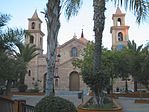Torrevieja: Difference between revisions
m fmt coor |
No edit summary |
||
| Line 97: | Line 97: | ||
*[http://www.spain-travel-guide.net/Torrevieja.htm Torrevieja Travel Guide in english] {{en}} |
*[http://www.spain-travel-guide.net/Torrevieja.htm Torrevieja Travel Guide in english] {{en}} |
||
*{{wikitravel}} |
*{{wikitravel}} |
||
*[http://www. |
*[http://www.torrevieja2009.eu Internet Web-Guide of Torrevieja 2009] {{en}} |
||
*[http://www.thisisspain.info/torrevieja This is Spain] {{en}} |
*[http://www.thisisspain.info/torrevieja This is Spain] {{en}} |
||
*[http://www.fctorrevieja.eu FC Torrevieja] {{en}} |
*[http://www.fctorrevieja.eu FC Torrevieja] {{en}} |
||
Revision as of 12:37, 11 October 2008
Template:Infobox City Spain Torrevieja in Spanish or Torrevella in Valencian is a seaside city and municipality located on the Costa Blanca in the province of Alicante, in south-eastern Spain.
Torrevieja lies about 30 miles south of the city of Alicante and has a population of 104,000 (2008). One of the great issues is that many foreign visitors do not register on the official census el padrón and many Spaniards with second homes are obliged to register in the town they are "habitually resident". Torrevieja was originally a salt-mining and fishing village as it is located between the sea and two large salt lakes (Las Salinas), which give Torrevieja a healthy micro climate.
History
Until 1802, Torrevieja existed only as an ancient guard tower, which gave the town its name (Torre Vieja (Spanish) means Old Tower) and some labourers' cottages. But in 1803, Charles IV authorized the movement of the salt mines from La Mata to the town itself and allowed the construction of dwellings there. In 1829, the town was totally destroyed by an earthquake but the mines were soon reconstructed and re-opened. In 1931, Alfonso XIII gave Torrevieja city status by special grant. During this period, there was also a growing market for flax, hemp and cotton.
In the 19th century, the salt was mainly shipped from the town by Swedish and Dutch ships. At the time, there was only limited demand from other regions of Spain, mainly Galicia and to a lesser extent, Valencia. Although by the dawn of the 20th century, a quarter of all the salt mined in Torrevieja, was sold in Spain itself and the rest exported was to foreign markets. Today, it is still an important industry in Torrevieja and a major employer. You can visit the Museum of Sea and Salt.
Recent

In recent years the local economy has hugely expanded due to the tourist industry. This includes both a strong contingent of British, Germans and Scandinavians, many of whom live there all the year round, and Spanish tourists who have a holiday home in the city. By 2004 Torrevieja had the largest number of British residents of all the Spanish municipalities (approx. 7,180), and that figure has now exceeded 12,000. The city is a conservative stronghold, with the Partido Popular maintaining an absolute majority at the Municipal Elections of 27 May 2007.
Over the past 6 seasons FC Torrevieja and its Torry Army have put the city on the football map of Spain with relatively huge crowds and a passion not normally seen outside La Liga.
The world-famous Habaneras festival for choral groups is held every August, when the city population expands roughly tenfold, like many other towns along the Costa Blanca.
Population
The INE (Spanish Census) of 2005 showed that the city had 84,838 residents, and the ayuntamiento (district council area) had 95,531 residents. By January 2008 this figure had reached 103,154 of which only 47,870 were Spanish!! 7,000+ of the Spanish residents were originally from Madrid and not for nothing is Torrevieja known as "la playa de Madrid" (The Madrid Beach). The most prominent nationalities in 2005 were:
| Nationality | Percentage | Nationality | Percentage | |
|---|---|---|---|---|
| Spanish | 47.80 | Colombian | 2.58 | |
| British | 13.30 | Ukrainian | 2.24 | |
| German | 5.15 | Moroccan | 2.17 | |
| Swedish | 3.14 | Norwegian | 2.17 | |
| Russian | 2.73 | Other | 13.30 |
Places of interest
- Iglesia Arciprestal de la Inmaculada Concepción - Originally erected in 1789 and then reconstructed in 1844, using stones reclaimed from the original Torre Vieja, (Old Tower).
- Iglesia de Nuestra Señora del Rosario (La Mata), constructed in 1896.
- Paseo de la Dique de Levante
- Parque de las Naciones or The Park of the Nations

- Museo del Mar y de la Sal (Sea and Salt Museum)
- Submarine S61 Delfin
- Las Salinas - The salt lakes to the west of the city.
- The Market
- Centro Habaneras - A semi-outdoor shopping mall.
- Paraje Natural Municipal Molino Del Agua - A natural park.
- Old Railway Station
- Water Fountains
- Club Skala
External links
- English Expat Phone Book & Online Directory In Spain Transclusion error: {{En}} is only for use in File namespace. Use {{lang-en}} or {{in lang|en}} instead.
- This is Torrevieja Transclusion error: {{En}} is only for use in File namespace. Use {{lang-en}} or {{in lang|en}} instead.
- TORREVIEJA.COM Tourism Website of Torrevieja Transclusion error: {{En}} is only for use in File namespace. Use {{lang-en}} or {{in lang|en}} instead.
- Torrevieja City Guide with Video Transclusion error: {{En}} is only for use in File namespace. Use {{lang-en}} or {{in lang|en}} instead.
- Information Website For Torrevieja Transclusion error: {{En}} is only for use in File namespace. Use {{lang-en}} or {{in lang|en}} instead.
- Official Website of Torrevieja Template:Es
- Torrevieja Travel Guide in english Transclusion error: {{En}} is only for use in File namespace. Use {{lang-en}} or {{in lang|en}} instead.
- Template:Wikitravel
- Internet Web-Guide of Torrevieja 2009 Transclusion error: {{En}} is only for use in File namespace. Use {{lang-en}} or {{in lang|en}} instead.
- This is Spain Transclusion error: {{En}} is only for use in File namespace. Use {{lang-en}} or {{in lang|en}} instead.
- FC Torrevieja Transclusion error: {{En}} is only for use in File namespace. Use {{lang-en}} or {{in lang|en}} instead.
